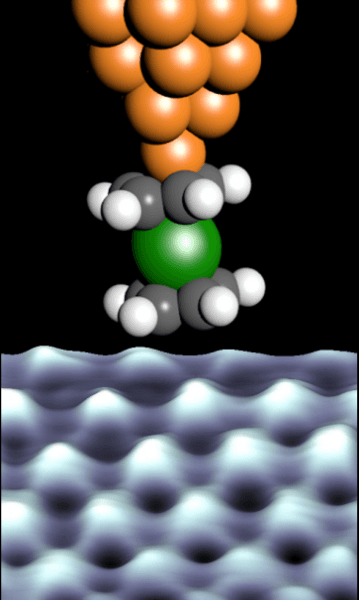Atomic-scale spin sensing with a single molecule at the apex of a scanning tunneling microscope
An international team led by Laurent Limot (Strasbourg), Markus Ternes (Jülich) and Nicolás Lorente, researcher at CFM and the Donostia International Physics Center (DIPC) has shown that minute magnetic fields can be detected using a magnetic molecule that is scanned along a surface. The scanning is made displacing the molecule on a metallic tip such that the displacements are sub-atomic and an electronic current is passed between the tip and the studied substrate. The small displacements are key to obtaining very high resolution but the new aspect of the work is to use a magnetic excitation of the molecule when electrons flow through it. The magnetic excitation can easily be perturb by the substrate yielding precious information on its magnetic structure.

Atomic scheme of a nickelocene molecule (atoms gray for carbon, white for hydrogen and green for nickel) attached to a single-atom terminated scanning tunneling microscope tip (orange atoms for copper). The lower part of the figure shows the differential conductance at the molecular tip scans the surface. The conductance shows atomic resolution of the different magnetic atoms (cobalt in the present case) showing that this technique can be used to learn about the spatial distribution of atomic magnetic moments.
The authors of the recent publication in Science specially crafted the tip apex to bring a novel function to the sharp tip: They made it sensitive to magnetic moments by placing a quantum molecular magnet containing a single Nickel atom. The molecule is shown in the figure in the configuration gleaned from geometrical studies mainly using calculations. The ground state of the molecule corresponds to a molecular magnetic moment parallel to the substrate surface. The molecule has a low-energy excitation of roughly 4 meV that corresponds to directing the magnetic moment perpendicular to the surface. The spin of this molecule is S=1 and is preserved in the depicted configuration. The excitation is easily performed by the flowing electrons in the figure’s set up because each electron efficiently undergoes a spin flip while exciting the molecular spin, to preserve the system’s total spin. The excitation opens a new conduction channel leading to a jump in the differential conductance of the molecular junction that is revealed in the measurements. This jump takes place at the bias matching the excitation energy. When the molecule is close to a magnetic object, the excitation energy changes due to the new magnetic excitations. As a consequence, the magnetic properties of the surface can be studied with sub-atomic resolution.
“A molecule at the tip of the tunneling microscope is the key to achieving unprecedented accuracy of magnetic detection on an atomic scale”
There are two important aspects of this work. First, the use of a molecule as active sensor makes it very reproducible and easy to implement in instruments used by other groups working in the field worldwide. Second, the detection scheme relies only on easily observable properties in the sensor tip and “dark” magnetic moments, which are usually difficult to measure, become accessible. In summary, with this work scientists have expanded their nanoscale toolbox with a new tool sensitive to the magnetic properties, which will be important for future applications ranging from nanoscale memory-devices to novel materials or applications in the field of quantum simulation and computing.



